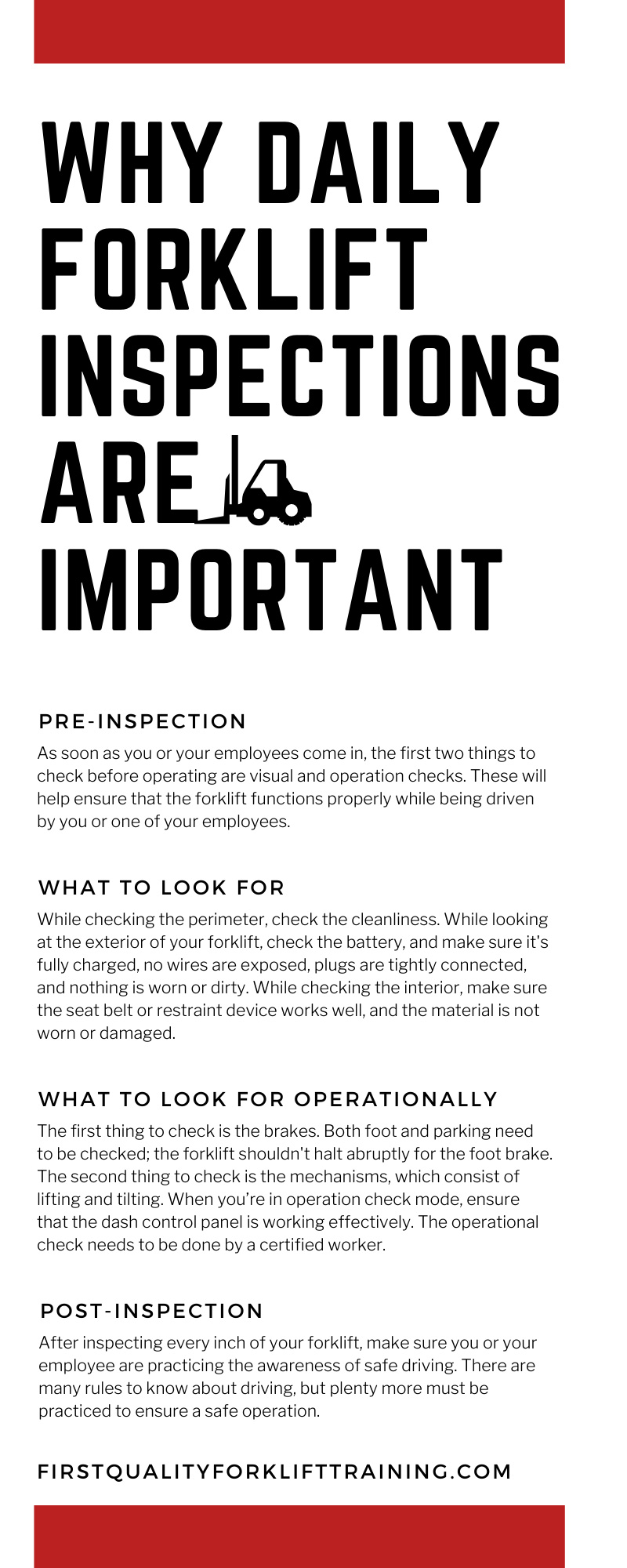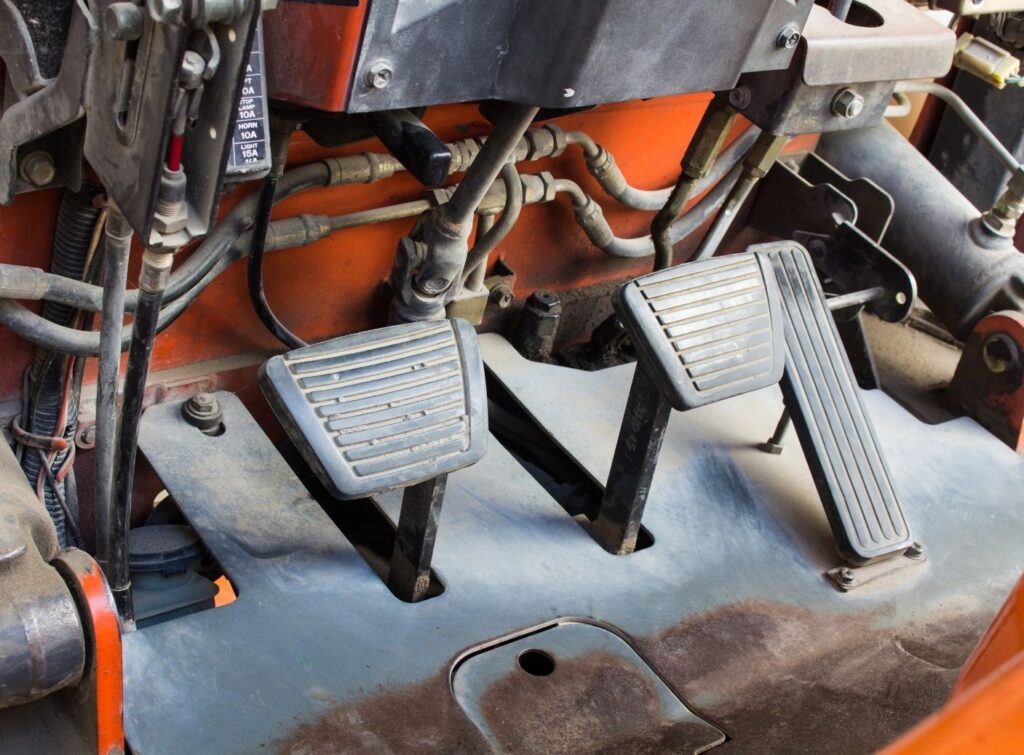Forklift Safety
Why Daily Forklift Inspections Are Important
All certified workers should inspect all types of industrial vehicles to help ensure the safety of employees and the lifespan of all heavy machinery. Listed below, you’ll find why daily forklift inspections are important. It’s important so you’ll know how to protect workers and what to look for when there’s a problem. Don’t only make a list for employees, but also to know what needs completed daily, which means before, during, and after operating any industrial vehicle. When it comes to inspecting, a few things to remember the importance of an operator. One, it’s vital to know that ongoing inspection is required. Second, employees need to be taught what to look for and how to manage their forklift. Third, proper training needs to be done before your employees can operate a forklift. Here is a breakdown of how to effectively remind your employees of why daily forklift inspections are essential.
Pre-Inspection
There is a multitude of things to look for as a forklift operator. As soon as you or your employees come in, the first two things to check before operating are visual and operation checks. These will help ensure that the forklift functions properly while being driven by you or one of your employees. Even if the equipment is hardly used, these are the critical components for daily forklift inspections.
What To Look For
You need to focus on certain things when doing visual checks are around, in, and outside the forklift. Inspections will help preserve an excellent safe workplace. Here are some things to look for when you are performing a visual check.
While checking the perimeter, check the cleanliness. If there’s any lint, oil, or grease built up, ensure that it’s cleaned immediately. Check your floors and ensure that the area is free of debris and obstacles that could block the forklift from being moved.
While looking at the exterior of your forklift, check the battery, and make sure it’s fully charged, no wires are exposed, plugs are tightly connected, and nothing is worn or dirty. Also, it’s highly suggested you should inspect whether the electrolyte levels of cells are up to par and that they’re being held down by brackets. Check the bolts, nuts, guards, and chains, including the hydraulic hose. Ensure none of those are missing, loose, or damaged. Additionally, remember to inspect the chain anchor pins. Check for any fluid leaks and make sure the hose or forks are not ruined. Look at your tires, if they’re pneumatic tires, and check the tire pressure to see if they need to be filled with air.
While checking the interior, make sure the seat belt or restraint device works well, and the material is not worn or damaged. Test that the seat belt can buckle adequately. Also, test out your horn to ensure that it’s loud enough for others to hear, so no one gets into any accidents. Lastly, examine your overhead guard to make sure it’s not damaged in any way.
What To Look for Operationally
Now that you’ve checked visuals, it’s time to inspect the operations of the forklift. Now, you might think this step includes driving the forklift but you simply need to check the necessary mechanisms so the forklift can function fully. During this check, make sure you and your employee aren’t picking any equipment up or operating the forklift in inappropriate ways before the operational review is complete.
The first thing to check is the brakes. Both foot and parking need to be checked; the forklift shouldn’t halt abruptly for the foot brake. What it should do is hold down well and make stops smoothly. For operators who are just starting, make sure you slowly coming to a halt before putting yourself in park. For the parking brake, the forklift should be able to hold when slightly accelerating. The Deadman seat brake (if equipped) is another brake you need to check.
The second thing to check is the mechanisms, which consist of lifting and tilting. These two work on the forks and the mast of the forklift. When lifting, raise the forks and lower to ensure they’re straight and they don’t randomly start and stop. Check this mechanism by leaning the forks forward and backward.
Take a look at your dash control panel. When you’re in operation check mode, ensure that the dash control panel is working effectively. The first part is the actual dash. Make sure the lights are on and pay attention to any flashing lights. If there are any problems, stop the forklift immediately, lockout and tagout the truck, remove the key, and get the problem fixed by qualified technician . Next, check your steering wheel by moving all the way left and right to ensure that you can turn when needed and that the wheel turns smoothly. Then, check directional control to make sure nothing jumps or jerks. Keep an ear open for any strange sounds or noises. Finally, inspect your lift cylinder, tilt cylinders and hoses for potential leaks.
The operational check needs to be done by a certified forklift operator. If you don’t currently hold a certification license, your employer can reach out to First Quality Forklift Training for necessary classes on completing a certification for operating a forklift. Interested employers can take up the opportunity by showing an OSHA forklift training video through First Quality Forklift Training while training potential forklift operators on the importance of having a daily checklist for your forklift.
Post-Inspection
After inspecting every inch of your forklift, make sure you or your employee are practicing the awareness of safe driving. Forklift operating is a potentially dangerous operation that can create terrible accidents if not driven properly. There are many rules to know about driving, but plenty more must be practiced to ensure a safe operation.
When operating a forklift, make sure to look in every direction to avoid collisions with other workers or inventory. When you are driving, sometimes it can be tempting to lean out of the forklift and wave at someone passing by. However, not looking in the direction your forklift is going can result in an accident. Additionally, when you are carrying a load, and it happens to be blocking your view, you should drive in reverse or get help in guiding the lift truck forward.
You need to be aware of the forklift’s environment. If the floor is wet and slippery, drive slowly. Don’t veer towards an edge if you are on a dock, and don’t pass another forklift while moving in the same direction. Both should move to the side before passing.
As you begin to learn the importance of daily forklift checks, you will realize that adequate training for forklift operators will help the drivers learn better to maintain a daily checklist for forklift driving. First Quality Forklift Training provides employers the opportunity to get their future, eager forklift operators certified and smarter with forklift operations.



Excellent content! Thank you for sharing pieces of advice and knowledge.